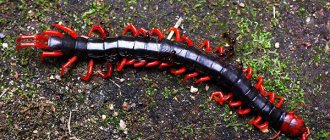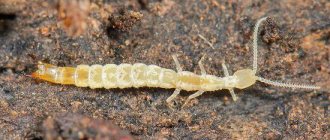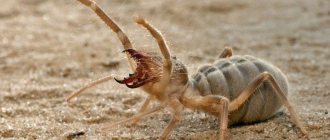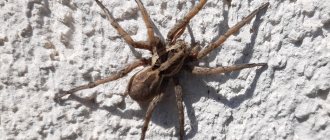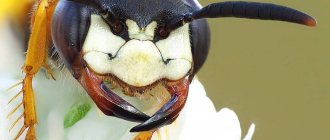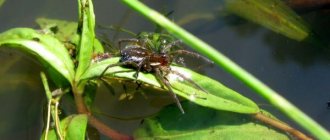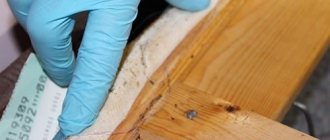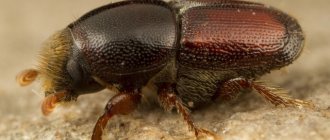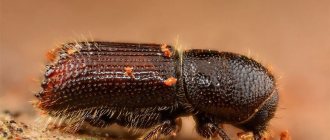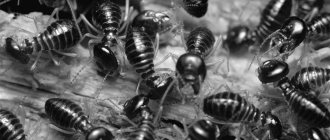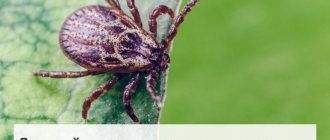Longhorned beetles are a fairly serious threat to wood, as it is part of their diet. Scientists know about more than 17 thousand representatives of this family. The most common is the black barbel. They are also called wood-boring beetles.
These insects damage plants that grow outside, as well as the wood from which houses and other buildings are made, as well as other wooden structures. They can turn wooden houses into dust, which you should not turn a blind eye to. At the first sign of the appearance of this pest, you should take care of how to get rid of it.
A little bit of biology
Longhorned beetles have fairly small sizes (from one to several tens of millimeters), a flat body and mustaches, which are the main organ of smell. The color of lumberjacks is usually brown or dirty gray; less commonly, the longhorn beetle is black. The photo allows you to examine the insect in more detail.
The larvae of the pest are characterized by particularly powerful jaws, thanks to which they can handle both hard wood and soft metal with a cable-type coating. However, the beetles do not eat the latter so readily, preferring wooden structures and stacked boards.
The female barbel lays her eggs (from 200 to 400 pieces) in recesses or cracks in the tree, and after 7-14 days the larvae are born, which instantly activate the process of destroying the tree.
It is worth emphasizing that it is almost impossible to immediately notice a tree disease, since the larvae lead a hidden lifestyle. So, you can understand that your wooden house has succumbed to the harmful effects of longhorned beetles only when the real results of their work (destroyed and loosening wood) are visible.
Features
The woodcutter beetle has a number of characteristic features that distinguish this type of pest from many others. These include:
- Long mustache. The longhorned beetle has prominent whiskers that are 2-5 times longer than the insect itself.
- Slender and elongated body. The length of the body varies from 3 to 60 mm.
- Wings. Some species of woodcutter beetles can fly.
- Hair.
Folk methods of struggle
Based on folk recipes, it is possible to prepare effective means of combating woodcutter beetles. For example:
- Take a 2.5% solution of sodium fluoride (250 g) and dilute it in 10 liters of water. Wooden structures are treated using a spray bottle, using 200 ml of product per 1 square meter.
- The product is prepared from identical parts of resin, black carbolic acid and naphthalene. The product is applied to the wood using a brush.
- It is permissible to treat wooden furniture with hot drying oil, but this method will deprive it of its attractiveness.
- Kerosene and turpentine are mixed in a ratio of 1:3. The tree is treated with Vaseline, and the prepared liquid is poured into the beetle passages. After this, the entrances are sealed with paraffin.
Types of longhorned beetles
There are many longhorned beetles, depending on certain characteristics they are combined into groups. Thus, woodcutter beetles that specialize in the destruction of spruce, pine and fir trees include the short-whiskered beetle, the shiny-breasted beetle, the ribbed beetle and the rustic beetle. The second group: large and small ragii, black spruce longhorned beetle, and bronze pine pest. They gnaw the needles, thereby damaging the health of the tree, and then settle into its wood. It is the active activity of pest beetles of the second group that is the most common cause of the extinction of entire areas of forested areas. The third group of longhorned beetles are squeaky beetles. They prefer deciduous trees, including birch, aspen, and willow. These include the greater and lesser squeakers, marbled squeakers, musky barbels, spiny barbels, as well as certain species of sandpipers.
What harm can they do?
Insects pose a danger to garden crops, garden and ornamental plants. Having settled in a summer cottage, they begin to actively devour any types of seedlings, garden shrubs, vegetables in the beds, and even corn and sunflowers. Insects can cause great damage to grapes.
Pests indiscriminately destroy all crops encountered in their path. The inhabitants of 2-3 earthen burrows are capable of destroying vegetation on an area of 5-7 sq.m. in a short period of time.
Sensing danger from a person, the crayfish can bite him. These bites do not pose a danger to people, but are extremely unpleasant.
Where can I meet you?
The longhorned beetle can live and reproduce not only in various tree species, but also in shrubs and herbaceous plants. Longhorned females lay their eggs in a crack in tree bark, in depressions on branches, trunks or stems. Moreover, the pests make these cracks and gouges themselves.
Lumberjacks can “visit” you at your dacha, and the forestry industry can “boast” of such guests. In country houses, the objects of pest attack are furniture, boards and other wood products.
Distribution and habitats
They are distributed throughout the world, but the greatest species diversity is observed in the tropics, where 90% of the largest subfamilies of the true longhorned beetles (Cerambycinae) and Lamiinae (Lamiinae) are found.
They inhabit mainly forest areas, sometimes found as pests on wooden buildings.
Great spruce black beetle (Monochamus sutor)
What to do if you find a barbel at home?
If a mustachioed pest is found in the house, then an emergency response is necessary. Why? It’s just that if this insect gets into wood, which is the main material of your home, then it will not calm down until it eats it or, as they say, if it doesn’t eat it, it will spoil it, causing significant damage to the building as a whole.
The longhorned beetle is not dangerous to humans, but it can harm him by destroying his home. To ensure that your home doesn’t care about insects, the wood should be treated during the construction stage. There are several ways to protect wood. Fumigation using phosphine gas is considered the most effective and optimal. This method of wood processing is held in high esteem by both owners of wooden buildings and carpenters, who process each unit individually.
A longhorned beetle visited your house and settled in it - a problem whose solution consists of the following actions:
— Assess the degree of damage to the material. To do this, you need to take a screwdriver and try to pierce the tree. If the tool enters easily, then it is impossible to do without eliminating a separate section of the surface of the house or the structure of the wood material (rafters, frames, beams). This is direct evidence that your house, or certain elements of it, is being eaten by a longhorned beetle. See photo of the damaged wooden beam below.
Hard wood can be left, but subjected to special treatment.
— Prepare the structure for the processing process. Clean the surface of the wood using a brush with increased rigidity. In this case, the person involved in this process must have special equipment: a respirator, glasses.
— Remove the dust layer with a vacuum cleaner.
- Coat the wooden surface with insecticide. Irrigate even surfaces, but intensively moisten holes and cracks with the product.
— Close all door and window openings in the room for several hours (usually 34 hours).
— If the wooden surface is open, it must be systematically treated with hot drying oil. It is worth remembering that this option is far from the best, because when processed with such material, the original texture of the material is subject to change.
- Resort to the use of special products that penetrate deeply into the tree and are distinguished by a long period of preservation of their properties: “Antizhuk”, “Empire-20”, “Antishashelin”.
— Treat the tree with antiseptics once every 12 months. It is best to do this in the month of June.
— Treat affected areas of wood with carbon disulfide.
— Expose the affected tree to high temperatures (within 74 degrees). This can be done with a specially designed device, which will not be difficult to find and purchase.
Prevention measures
To prevent longhorned beetles from causing damage to your structure, you must:
- carry out a thorough inspection of the wood for the presence of holes made by insects;
- if damage is detected, use special protective equipment;
- keep the room dry, since excessive humidity is one of the favorable living conditions for insects;
- for preventive purposes, wooden surfaces must be periodically treated with special insecticidal agents;
- for construction, use material that is not infected with insects; this is easy to verify when the wood is cleared of bark;
- If wooden structures are heavily infested, they should be replaced with new elements.
By periodically carrying out these simple measures, you can protect your home from pests.
Longhorned beetle: how to get rid of it?
Special means of varied action will help you fight barbels in your own home. Which specific product to choose in this or that case is entirely up to you!
Conventionally, such funds can be divided into three groups:
- Contact. They manifest their effect directly upon contact with the longhorned beetle. Such products are not popular because their use can be harmful to human health.
- Intestinal. Such agents include sodium fluoride, zinc chloride and other components that exert their harmful effects on the insect through the intestines.
- Fumigants. These are gaseous and vaporous substances: sulfur dioxide, dichloroethane, etc.
Remember that solid wood, on the surface of which there are no cracks or other defects, is not of interest to pests. The longhorned beetle will live and reproduce only in cracks. Therefore, you can’t go wrong if you pour a special product into the grooves of the wood panel with a syringe, and then cover these holes with wood putty or ordinary plasticine.
Remember that it is very difficult to overcome barbels! It is much easier to resort to preventive methods, for example, using exclusively wood impregnated with fungicides for construction purposes.
Pay attention to wood processing
Defects in boards and beams, the presence of nicks, cracks, and rot are convenient places for beetles to lay. Gaps between logs, beams, and tow made from natural materials are a direct invitation to woodworms into the house. Use mineral wool, insect repellent, seal all cracks until completely smooth. The wood must be treated with a special impregnation, and then covered with drying oil and varnish or a liquid coating with a plasticization effect.
When using varnishes and drying oils, the outer coating of wood must be renewed annually. Otherwise, insects will destroy the house very quickly. In cold climates with long winters, the activity of woodcutter beetles is not too great. Houses can stand for hundreds of years and remain strong. In humid and warm climates, beetle larvae pose a serious danger and very quickly destroy unprotected tree structures.
This is interesting!
The longhorned beetle family includes not only annoying wood pests, but also representatives of the Red Book of Russia. One of them is the relict longhorned beetle (woodcutter). Its habitat is the deciduous forest of the Far East. A distinctive feature is the body length, reaching 11 centimeters. Meeting such a beetle is a great success. The titan lumberjack, which has received the status of “the largest beetle on the planet,” and the long-legged harlequin, whose front limbs are longer than the length of the body, also need protection.
Interesting Facts
- Despite its powerful jaws, capable of chewing through a pencil, the beetle's bite is not dangerous to humans. He is not capable of causing him serious harm.
- An adult longhorned beetle, even a giant one, eats very little. Sometimes he lives only thanks to the reserves that he accumulated as a larva. Females feed more than males to ensure normal egg maturation.
- In her territory, the female most often has no rivals. She secretes a special pheromone that attracts males and repels other females.
- A grown beetle lives for one summer season, a maximum of 2-3 months, and the larva is much longer, for years, in some species up to 10 years.
- Some futurists predict that in the future we will eat wood. If you study and use the digestive system of the longhorned beetle, it is quite possible to do this. Its intestines are equipped with special bacteria that process cellulose into easily digestible carbohydrates. Periodically, the larvae process these bacteria, obtaining additional nutrients from them. Waste-free production.
- It may seem strange, but not butterflies and bees, but the longhorned beetle is inextricably linked with flowering plants. They spend most of their short lives on flowers. And because of their size, they pollinate a large surface. Thanks to his taste preferences, some plants have been preserved and survived in nature.

